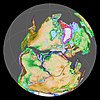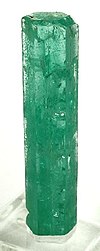Paja Formation
The formation was named after Quebrada La Paja in Betulia, Santander, and stretches across 450 kilometres (280 mi) from northeast to southwest.
The Paja Formation comprises mudstones, shales and nodules of sandstones and limestones, deposited in an anoxic environment, in the warm and shallow sea that covered large parts of the present Colombian territory during the Cretaceous.
The type section is exposed on the northern banks of the quebrada at the confluence of the Sogamoso River in Betulia, Santander.
[8] In the Middle Magdalena Valley, south of Barrancabermeja, the Paja Formation in the subsurface is offset by the Casabe, Infantas and Arruga Faults.
[9] In the northeastern extent, in Río Negro, near the border with Norte de Santander, the formation is found in the subsurface, offset by the Lebríja Fault.
[15] The urban centers of Oiba, San Benito, Encino, Ocamonte and Charalá are built on top of the Paja Formation.
[20] North of Lake Fúquene, the town centers of Tinjacá and Sutamarchán are built on top of the Paja Formation.
[7][22] Along the highway Tunja-Villa de Leyva, the formation is heavily folded and faulted along a stretch of 500 metres (1,600 ft).
[23] In the vicinity of Villa de Leyva, the formation has provided many fossils of marine reptiles, as well as the dinosaur Padillasaurus.
[27] The Paja Formation is subdivided into three members, from oldest to youngest: In the northern part of the Middle Magdalena Valley, the Paja Formation comprises dark grey to blueish shales, intercalated with grey to yellowish fine-grained sandstones and fossiliferous limestones, locally with a sandy component.
[39] The Barremian to Aptian sequence shows evidence of an overall relative sea level fall with open marine sedimentation in the lowest member and tidal deposits in the upper part of the formation.
[42] These spikes indicate a global change in the carbon cycle and the preservation of organic matter due to poor oxygenation of sea waters.
In western San Pablo de Borbur, Boyacá, the mineralization dates to the Late Eocene at 36.4 ± 0.1 and 37.3 ± 0.1 Ma.
Fauna of dinosaurs, Padillasaurus, and various marine reptiles, among which plesiosaurs, ichthyosaurs, pliosaurs and turtles make up the vertebrate assemblage.
Paja ammonites have been used in the walls and floor of the Convento del Santo Ecce Homo [es] near Villa de Leyva.
[56] Within the Arcillolitas Abigarradas Member of the Paja Formation, some horizons preserve abundant wood, which is frequently bored by pseudoplanktonic pholadoid bivalves, commonly referred to as "shipworms" or "piddocks".
In respect of the 'world's most complete record of Lower Cretaceous marine reptiles and associated fauna', the International Union of Geological Sciences (IUGS) included the 'Marine Reptile Lagerstätte from the Lower Cretaceous of the Ricaurte Alto' in its assemblage of 100 'geological heritage sites' around the world in a listing published in October 2022.







































































